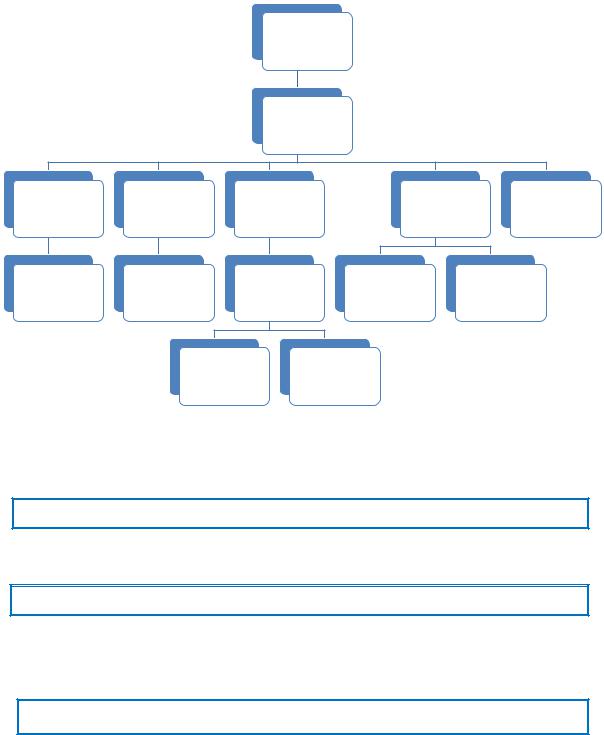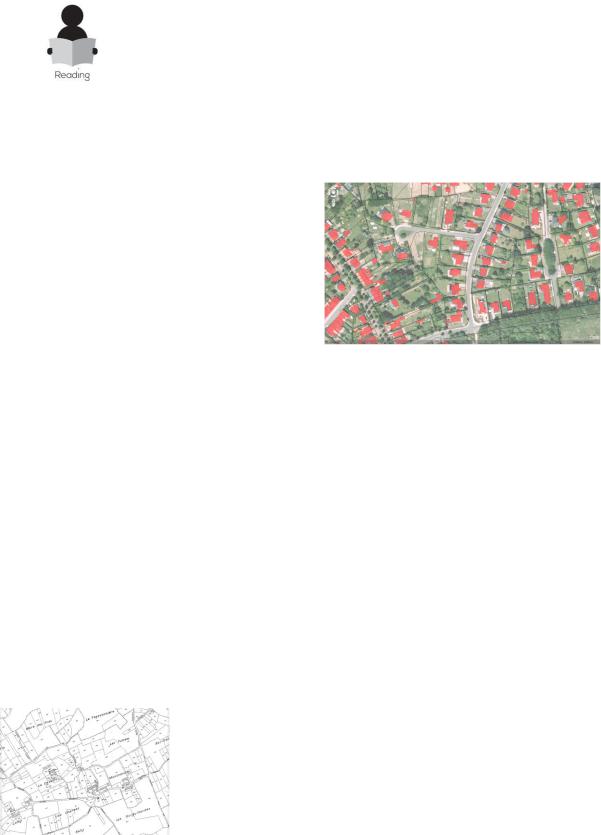
ПОСОБИЕ_English_for_economists_посл
..PDF
строгий надзор), самореализованность, функциональные структуры выполняют
большой объем операций.
6. Using vocabulary in ex.2 match the words with their appropriate meanings.
1 |
Centralization |
a |
departments represent the unique products, |
|
|
|
services, customers, or geographic locations the |
|
|
|
company is serving |
|
|
|
|
2 |
Tall structures |
b |
involve a larger number of employees reporting |
|
|
|
to each manager |
|
|
|
|
3 |
Functional structures |
c |
decisions are made and problems are solved at |
|
|
|
lower levels by employees |
|
|
|
|
4 |
Centralized companies |
d |
there are many written rules and regulations |
|
|
|
|
5 |
Flat structures |
e |
the degree to which decision-making authority |
|
|
|
is concentrated at higher levels in an |
|
|
|
organization |
|
|
|
|
6 |
Decentralized companies |
f |
many important decisions are made at higher |
|
|
|
levels of the hierarchy |
|
|
|
|
7 |
Divisional structures |
g |
group jobs based on similarity in functions |
|
|
|
|
8 |
Formalized companies |
h |
the number of employees reporting to each |
|
|
|
manager tends to be smaller, resulting in greater |
|
|
|
opportunities for managers to supervise and |
|
|
|
monitor employee activities |
|
|
|
|
7. Discuss with the group the following topics:
Make up a presentation about a well-known company. Pay
attention to its structure and type of management.
111

FINAL TASKS
1. Read the short presentation of the management team of this British company. Then write the correct letters (a-n) in the right places in the organization chart.
At the top of the company, the Chairman of the Board [a] is responsible to the shareholders and the day-to-day running is the responsibility of the Chief Executive Officer (CEO) [b], who also has a seat on the Board.
Five directors form the senior management committee of the company. Going from left to right on the organization chart, we start with the Director of Finance [c], who runs his division with his Deputy [d].
Then we have the Director of Operations [e], who is responsible for production and logistics. The Factory Manager [f] answers directly to him.
Next we have the Director of Marketing [g], who is responsible for sales so the National Sales Manager [h] reports to him on the activities of the whole sales team, which is divided into two regions, north and south, each managed by a regional sales manager [i, j].
The Director of Human Resources [k] has a Training and Development Manager [l] and a Compensation and Benefits Manager [m], who look after the day-to-day running of her department.
Finally, the Director of Research and Development [n] runs a small but important division of the company. She too reports directly to the CEO.
112

1 a
2
3 |
4 |
5 |
6 |
7 |
8 |
9 |
10 |
11 |
12 |
13 14
2. There is a list of management theories over the last five hundred years. In each
pair decide which statement is true.
1. Machiavelli The Prince (1513)
a)You have to be cleverer than your opponent, sometimes using force or trickery.
b)You have to kill your opponents.
2. Marx and Engels The Communist Manifesto (1848)
a)The Communist Party will dominate the world.
b)The working class will rise up and take power from the bourgeoisie, creating a utopia of equality and brotherhood.
3.Taylotism (1911)
a)A ‗scientific‘ approach to management based on measuring time, performance and output and relating these to wages and salaries.
b)A system of management based on friendly co-operation between managers and
workers.
113

4. Hawthorne studies (1924-1932)
a)Studies showing that factories produce more if workers are put under increased
pressure.
b)Studies showing the relationships between management and workers are very important in getting the best performance.
5. Elton Mayo (1930s)
a)The idea that social needs and relationships are very important factors in the workplace.
b)The belief that workers should be able to control the work environment.
6. Maslow’s Hierarchy of Needs (1942)
a)The idea that people have needs which motivate their performance. Once a need is met, it is no longer motivating.
b)The idea that workers and managers have the same needs and have to co-operate.
7. Systems approach (1950s and 60s)
a)Belief that organizations consist of many parts and management has to help each part to work both individually and as part of the whole organization.
b)Belief that a company is a single organization. Managing the single organization from the top brings success.
8. Contingency theory (1980s and after)
a)Idea that organizations are all similar and have the same objective – profit.
b)Management must study every situation and design the best response.
3. Think of the situations where you can use the following idioms.
As bad as luck would have it, black money, cost a pretty penny, count one‘s chickens before they are hatched, cut-throat competition, get one‘s money‘s worth, give smb. credit
(for smth.), have a heart of gold, have no business, a stroke of good fortune.
4. Speaking.
Preparing a Business Plan
The business plan is an important document with two essential functions. It aims to convince possible investors and other stakeholders of the potential of a new business. It also works as a guide for the company in its first year
114
or two of operation.
The business plan normally starts with a title page and outline of the new business. It includes the name, logo and mission statement of the activity. There are normally three main parts to the business plan.
First, the Marketing Plan. This includes a description of the products and services, an analysis of the market, a survey of the competition and a basic outline of promotion and selling strategies.
The next part is the Financial Plan, which includes details of start-up costs, a profit and loss forecast for the first year or two (or maybe three) and then a calculation of the breakeven point. This is to show when business expects to begin making a profit.
Then there is usually a People and Action Plan. This explains who is involved, and states their roles and responsibilities, their experience and abilities. The Action Plan explains what will happen in the important first year of the business, i.e. during the start-up phase.
Finally, the business plan has some information on the location, perhaps with photographs and architect‘s drawings. At the end there are the Appendices, containing any additional information and detailed information or support material.
(Source: Professional English. Management)
5.Translate the following sentences using the vocabulary of Units 7.
1.Награждение сотрудников также является ключевой частью обязанностей менеджера по продажам. 2. Он застройщик, акционер и директор ряда компаний. 3.
Процесс планирования управления рисками начинается с постановки целей и создания политики управления рисками. 4. Это механизм, посредством которого общество стремится к достижению политических целей. 5. Так как люди планируют свое будущее, полезно провести SWOT-анализ – сильные стороны, слабые стороны,
возможности и угрозы. 6. Компания увеличила объемы производства, чтобы максимизировать доходы организации. 7. Хороший менеджер должен обладать многими качествами, среди которых профессионализм и ответственность играют важную роль. 8. В этой стране недавно прошла централизация политической власти. 9.
Маркетинговый план играет важную роль в успешной работе компании. 10. Он работает в отделе продаж уже 3 года.
115

Unit 8.
Cadastre
Text 8A
1.Before you start.
1.What do we need land for?
2.Make a list of all types of activities that we can apply land for.
2.Read the words and learn them by heart. Make up your own
sentences with them.
1.cadastre – кадастр
2.metes-and-bounds – границы, пределы
3.ownership – собственность, владение, право собственности
4.tenure – владение, собственность, имущество
5.the precise location – точное местоположение
6.parcels of land – участок земли, надел земли
7.conjunction – соединение, объединение, стык
8.title register – реестр титулов
9.disputes – разногласия, споры
10.lawsuit – судебный процесс, иск
11.Bureau of Land Management – Бюро по управлению государственными и общественными землями, Государственный комитет по земельным участкам
12.poll tax – подушный налог, избирательный налог
13.taxation – налогообложение, взимание налога
14.parish – приход, уезд, округ
15.riding – зд. райдинг (название округа в графстве Йоркшир, Великобритания)
16.hundred – зд. округ (часть графства в Англии)
17.lot – зд. участок (земли), надел
18.valuation – оценка, определение стоимости
116

19.forerunner – предшественник, предвестник
20.to assess – оценивать, оценивать имущество для обложения налогом,
3.Read the text 8A, translate it and compare your ideas in ex.1 with the facts.
Cadastre
A cadastre (also spelled cadaster), using a cadastral survey or cadastral map, is a
comprehensive register of the real estate or real property's metes-and-bounds of a country.
A cadastre commonly includes details of |
|
the ownership, the tenure, the precise location, |
|
some include GPS coordinates, the dimensions |
|
and area, the cultivations if rural, and the value |
|
of individual parcels of land. Cadastres are used |
|
by many nations around the world, some in |
|
conjunction with other records, such as a title |
http://orbitgis.com/sites/default/files/ |
|
|
register. |
|
In most countries, legal systems have developed around the original administrative systems and use the cadastre to define the dimensions and location of land parcels described in legal documentation. The cadastre is a fundamental source of data in disputes and lawsuits between landowners.
In the United States, Cadastral Survey within the Bureau of Land Management (BLM) maintains records of all public lands. Such surveys often require detailed investigation of the history of land use, legal accounts, and other documents.
Etymology
The word cadastre came into English through French from Late Latin capitastrum, a register of the poll tax, and the Greek κατάστιχον katastikhon, a list or register, from κατὰ στίχον kata stikhon – literally, "down the line", in the sense of "line by line" along the directions and distances between the corners mentioned and
marked by monuments in the metes and bounds.
The word forms the adjective cadastral, used in public administration, primarily for ownership and taxation purposes.
http://cmapspublic.ihmc.us/rid=1J6J36CCS
117

The terminology for cadastral divisions may include counties, parishes, ridings, hundreds, sections, lots, blocks and city blocks.
Cadastral surveys
Cadastral surveys document the boundaries of land ownership, by the production of documents, diagrams, sketches, plans (plats in USA), charts, and maps. They were originally used to ensure reliable facts for land valuation and taxation. An example from early England is the Domesday Book in 1086. Napoleon established a comprehensive cadastral system for France that is regarded as the forerunner of most modern versions.
Cadastral survey information is often a base element in Geographic/Land Information systems used to assess and manage land and built infrastructure. Such systems are also employed on a variety of other tasks, for example, to track long-term changes over time for geological or ecological studies, where land tenure is a significant part of the scenario.
Cadastral map
A cadastral map is a map that shows the boundaries and ownership of land parcels. Some cadastral maps show additional details, such as survey district names, unique identifying numbers for parcels, certificate of title numbers, positions of existing structures, section or lot numbers and their respective areas, adjoining and adjacent street names, selected boundary dimensions and references to prior maps.
(Source: http://en.wikipedia.org)
4.Say if the sentences concerning Text 8A are true or false.
1.A cadastre is evaluation of real estate.
2.Legal systems use the cadastre to define the dimensions and location of land parcels described in legal documentation.
3.The word ―cadastre‖ came into English from Dutch.
4.Cadastral surveys document the boundaries of land ownership.
5.A cadastral system established by Henry III for England is regarded as the forerunner of most modern versions.
6.A cadastral map is a map that shows the boundaries and ownership of land parcels.
5.Answer the following questions.
1.What is a cadastre?
2.What does cadastre include?
3.What can you tell about the etymology of the word ―cadaster‖?
118

4. What does the terminology for cadastral divisions include?
5.What do cadastral survey document?
6.How is cadastral survey information used? 7.What is a cadastral map?
6.Give English equivalents of the following words and word combinations from Text 8A.
Кадастровая съемка, всесторонняя (полная) регистрация, границы частной собственности, точное местоположение, стоимость отдельных участков земли,
регистрация права собственности, административные системы, основной источник данных, подушный налог (избирательный налог), округа, административная единица или избирательный округ, границы владения землей, надежные (достоверные) факты,
оценка и налогообложение земли, предшественник.
7. Discuss with the group the following topics:
Describe a piece of land you know well according to the plan:
1)location;
2)area (sq.m.)
3)streets or lands surrounding environment;
4)purpose of the area
Text 8B
1. Before you start.
Where do you live?
Do you live in a house or apartment?
Is it big?
Does it have a garage or a garden?
119

2. Read the words and learn them by heart. Make up your own sentences with
them.
1.immovable – неподвижный, недвижимый
2.permanent – постоянный, неизменный
3.Jeremiah – Пророк Иеремия
4.sealed deed – запечатанный документ
5.to facilitate – содействовать, способность
6.impetus – импульс, стимул, мотив
7.registration of deeds – отдел земельной регистрации, регистрация прав на недвижимость
8.registration of title – регистрация прав, оформление прав, оформление права на имущество
9.double selling – двойные продажи
10.claim – иск, требование, претензия
11.database – база данных
12.fiscal cadastre – фискальный кадастр
13. legal cadastre – юридический кадастр
3. Read the text 8A, translate it and compare your ideas in ex.1 with the facts.
Land Registration System: History and Definitions
Two unique characteristics of land distinguish it from other types of property. First, land is immovable, so it cannot be physically transferred from one person to another. Second, land is permanent; it cannot be increased, decreased, or destroyed as can all other forms of wealth. Land's permanence makes it peculiarly capable of lasting record.
Land tenure and title featured prominently in early agricultural economies. Contracts entered into as early as the third millenium B.C. demonstrated that people needed tenure security in the land they cleared. The Bible tells of an early land transaction in the book of Jeremiah. In 587 B.C. Jeremiah bought his cousin Hanameels's field in a purchase of land that involved a sealed deed prepared in accordance with legal requirements. Official records of land ownership date even further to 3000 B.C., where in ancient Egypt rulers kept a Royal Registry to record land ownership for taxation purposes. Much later in Europe, land records
120
